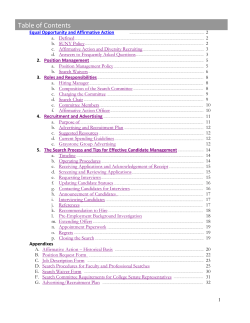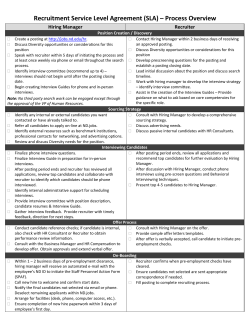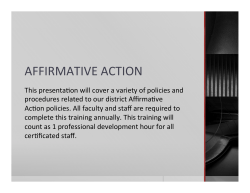
Search Committee Briefing Process
Affirmative Action Officer 2013 Search Committee Briefing Affirmative Action & Equal Opportunity in the Faculty Search Process I. Affirmative Action Placement Goals A. Where there are fewer women or people of color employed in a job group than would be expected based on calculated availability (or otherwise known as a “placement goal”), we have a specific obligation as a federal contractor to engage in a good faith effort to make progress toward addressing that underrepresentation. That begins with a thoughtful, targeted outreach and recruitment effort every time we have the opportunity to make a hire into the job group. We also have an obligation to prepare for future hires by engaging in outreach to targeted communities and developing strategies to examine internal policies, procedures, and communication efforts to address any underrepresentation. To know if there is a placement goal, review the annual affirmative action plan or contact the Affirmative Action Officer. B. Search committees need to develop broad and appropriately targeted recruitment strategies designed to attract a broad and diverse applicant pool that includes women and people of color. Federal regulations also require good faith efforts to target qualified covered veterans and individuals with disabilities pursuant to the Vietnam Era Veterans’ Readjustment Assistance Act (Section 4212) and The Rehabilitation Act of 1973 (Section 503). Examples of outreach and recruitment resources include: relevant professional organizations, people of color or women’s special interest groups or caucuses within professional organizations, relevant professional journals, The Chronicle of Higher Education, general higher education minority recruiting organizations, publications or websites and contact with colleagues at other organizations who might know of promising candidates. We must document these efforts and the candidates that result from these efforts to help us measure success in our recruitment efforts. Affirmative Action Officer 2013 If every candidate pool is as diverse as reasonably might be expected based on availability in the labor market, we can expect over time to employ a workforce that reflects the true representation of qualified women and minorities within which we recruit. A successful affirmative action program is measured by demonstrated effort, not by meeting or exceeding the placement goals. Above all, the MOST qualified candidate must always be selected without regard of race, color, national origin, sex, pregnancy, age, disability, creed, religion, sexual orientation, gender identity, gender expression or veteran status. The key to satisfying our affirmative action responsibilities is measured by the actions we take to recruit a diverse applicant pool. To request assistance in identifying additional resources available for targeted recruitment efforts, contact the Affirmative Action Officer. II. Equal Opportunity in the Selection Process A. General – Once a broad and targeted outreach and recruitment effort has been implemented and the search committee turns to identifying the most qualified candidates from among the applicants, the focus shifts from taking affirmative action to recruit a diverse applicant pool, to ensuring equal opportunity in the applicant review process. 1. As applications are received, the hiring department should acknowledge receipt of applications, solicit ethnicity, race, and gender information as per federal regulations requirements under Executive Order 11246, and maintain confidentiality. CU-Boulder utilizes Jobs@CU as the system to collect applications and manage these processes. 2. Before beginning to review the applications, search committees are encouraged to contact the Affirmative Action Officer regarding the diversity of the applicant pool. If the pool is not as diverse as we might expect based on availability, the committee and/or hiring authority should consider whether additional outreach and recruitment efforts might result in a more diverse pool. B. Evaluation of Written Application Materials 1. Prior to review of written application materials, the search committee needs to have a thoughtful and thorough discussion about selection criteria – what kinds of training, experience, accomplishments or other job-related attributes are relevant to success in the position. Affirmative Action Officer 2013 2. In defining the selection criteria, the search committee needs to exercise care to ensure that: a. The criteria are grounded in the position as posted – they are either addressed in or reasonably can be inferred from the job announcement. b. The criteria are defined to be useful in guiding the selection decision but broadly enough to avoid eliminating strong candidates who, despite having a less traditional background and/or experience, may have the skills and experience necessary to be successful in the position and would bring a different approach or perspective that would add value to the position. c. The criteria have been critically reviewed in an effort to ensure that they are free from non-job-related bias that might inadvertently eliminate otherwise qualified protected group candidates from ongoing consideration. 3. Candidates who meet the stated minimum qualification move on to review of preferred qualifications; candidates who do not meet minimum qualifications do not move on UNLESS the position is redefined and re-advertised. C. Short List – selecting candidates for initial interview 1. If the search committee is challenged in deciding how many candidates to include in the initial interview phase because of the number of strong and viable candidates, they are encouraged to contact the Affirmative Action Officer to see if where they draw the line in terms of candidates for initial interview would make a difference in maintaining diversity in the applicant pool. If the very top group does not include gender, race or ethnic diversity but expanding that group would maintain the opportunity for a diverse hire, the committee is encouraged to consider extending the initial interview list so long as that does not result in interviewing candidates the search committee has determined are not viable. The Affirmative Action Officer will not be able to provide specific information on the identity of those whom are from a specific demographic. 2. There is no magic number of minimum or maximum candidates for initial interview. The search committee may interview as many candidates as it deems necessary. The search committee needs to have a job-related explanation supporting its decision as to candidates selected for interview and those eliminated from further consideration. Federal regulations require we identify Affirmative Action Officer 2013 why individuals were not selected to properly investigate any potential barriers of equal opportunity. Therefore, it is important all candidates are documented with a job-related explanation why they were not selected other than, “NotSelected” or “Other Candidate Selected”. For example, if a candidate was not selected due to less experience, education, or research experience, it is important to document as such. Again, Jobs@CU allows for the selection of notselection identifications. D. Interviews 1. As with all steps in the selection process, consistency and fairness are critical. a. Interview questions must be clearly job-related and designed to help the search committee determine which candidates have the training, experience, skills and ability to best perform the essential functions of the job. b. Each campus interview should include the same opportunities – meetings with constituency groups, administrators, etc. c. Care must be taken to gather the same job-related information for each candidate through consistency in questions posed by the search committee and input received from other constituency groups involved in the on-campus interview process. 2. To ensure equity in the selection process, avoid: a. Asking additional questions of one candidate that are not asked of others. However, additional questions can and should be asked to obtain or clarify an answer to a question asked or to clarify information in a candidate's application materials. b. Asking questions that elicit personal information rather than jobrelated information. Some non-job-related information, such as number and age of children, can lead to discrimination. The less non-job-related information you have, the less that could possibly enter into, or be perceived as entering into, a selection decision. 3. We have an obligation under the law to provide reasonable accommodation to both applicants and employees with disabilities. An applicant with a disability may require accommodation in order to participate in the application and Affirmative Action Officer 2013 selection processes. E.g., someone with mobility impairment will require that interviews be conducted in locations that are physically accessible. a. In order to meet our accommodation obligations without violating the Americans with Disabilities Act (ADA), when inviting candidates it is useful to ask a carefully worded question that gives candidates the opportunity to identify any special needs without asking about a disability. (e.g. “Are there any special considerations of which we should be aware in planning your visit?”) E. References 1. Checking references is a critically important part of the selection process. As with all other steps in the selection process, consistency and fairness are paramount. Reference questions must be clearly job-related and directly relevant to a candidate’s potential success in the position. The search committee or hiring authority should take care to be gathering the same body of information for each candidate. a. The search committee/hiring authority is not limited to contacting those references identified by the candidate. However, to ensure respect for candidates in the selection process, it is a professional courtesy to let candidates know if additional references are being contacted. b. Where additional references are contacted, the search committee or hiring authority should have a clear and job-related rationale for contacting those references. F. Final Selection Decision 1. The guidelines implementing our affirmative action related obligations are very specific in requiring that decisions be based on merit, rather than on gender or race. Therefore, under no circumstances should a clearly less qualified candidate be selected or elevated in the selection process over a clearly more qualified candidate. However, as noted above, please be aware that how the selection criteria are defined will determine who emerges as most qualified and must not unfairly disadvantage applicants from protected groups. Affirmative Action Officer III. 2013 Search Process Documentation A. Search Plan (Pre-Selection): The search or recruitment plan is prepared prior to the job posting and must be approved by the Affirmative Action Officer prior to the commencement of the search The Search Plan is our record that documents outreach and recruitment efforts, criteria for selection, and search committee members. B. Search Summary (Post-Selection): One a candidate is selected, the hiring authority must submit a summary of the search to the Affirmative Action Officer. The Search Summary confirms the information provided in the search plan and includes a list of all candidates who were interviewed, with candidates’ relative strengths and job-related reasons for selection or non-selection. We are required to maintain the application materials and note reasons for non-selection for all candidates in the search process, including those not interviewed. The department can either note those candidates’ final status within Jobs@CU or submit a list of those candidates directly to the Affirmative Action Officer. NOTE: This is a change from past practice when reasons for nonselection were required only for candidates who were interviewed. C. When the search has been completed, the search committee chair needs to gather all search-related materials from all committee members. This includes all evaluative notes, interview and reference check notes, reference letters, correspondence with or about each candidate, etc. All of the search materials must be included with all the applications received for the position, marked clearly as a search file, and retained for three years. IMPORTANT: Failure to retain search documents could lead to an inference of discrimination if an applicant or candidates alleges discrimination in the recruitment process. For more information or assistance, contact the University of Colorado Boulder Affirmative Action Officer: Torrey S. Tiburzi, SPHR 303-735-3846 (p) aao@colorado.edu torrey.tiburzi@colorado.edu
© Copyright 2025





















